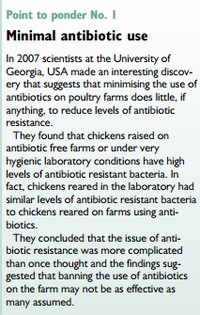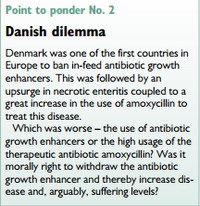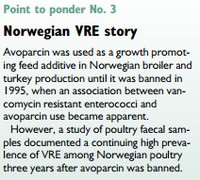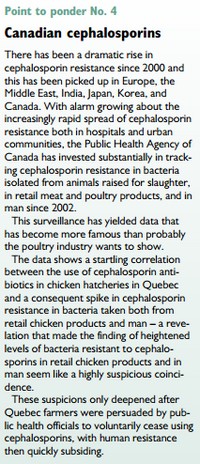A Practical and Logical Look at Antimicrobial Resistance in Poultry
Published: January 18, 2013
Source : Poultry CRC
Antimicrobial or antibiotic resistance is an emotive and often misunderstood topic. It is a subject that many, including governments, academics and consumers, use as a stick to beat our industry with! With this article we hope to give you a clearer picture of some of the issues involved and endeavour to look at the subject from a practical/field point of view rather than a theoretical/academic position.
Antimicrobial resistance can be defined as the resistance of a micro-organism, usually a bacterium, to an antimicrobial to which it was previously sensitive. This highlights a very common misconception. People talk about ‘antimicrobial resistance in poultry’ when, in reality, we are talking about antimicrobial resistance in bacteria present in the birds or likely to infect the birds. That is, there is nothing innately wrong with the poultry. 

Bacteria can become resistant in different ways – some destroy the antimicrobial, for example by producing enzymes against it, some prevent antibiotic getting into their cells and others get the antibiotic out of their cells before it can harm them.
Some bacteria are naturally or innately resistant and new resistances can occur spontaneously by chance mutations and these resistant strains then multiply. The resistant strain can then increase its dominance if, for example, it multiplies quicker or other non-resistant strains are killed off by antibiotic therapy.
Some bacteria are naturally or innately resistant and new resistances can occur spontaneously by chance mutations and these resistant strains then multiply. The resistant strain can then increase its dominance if, for example, it multiplies quicker or other non-resistant strains are killed off by antibiotic therapy.
In this context, the more antibiotics given to man or animals the greater the selective pressure that favours resistant strains. This is a good example of Darwin’s theory of evolution and ‘survival of the fittest’. So, antibiotics do not cause resistance but
they create an environment that favours the growth of resistant variants of the microorganism that already occur or arise by mutation. As bacterial multiplication occurs so dominance by a resistant strain can quickly arise.
they create an environment that favours the growth of resistant variants of the microorganism that already occur or arise by mutation. As bacterial multiplication occurs so dominance by a resistant strain can quickly arise.
Three key areas of concern
If we look at this subject from a human point of view, there are probably three key antimicrobial resistances of concern. The first is that of multidrug-resistant tuberculosis, of which there are half a million or so new cases and 150,000 deaths per year.
The second is resistance to earlier generation antimalarial drugs, such as chloroquine and sulphadoxine-pyrimethamine, which is now widespread in most countries in which malaria is epidemic.
The third resistance of concern is that found in a high percentage of hospital acquired infections such as those caused by the highly resistant bacterium, methacillin resistant Staphylococcus aureus or MRSA. Antimicrobial resistance is of concern to the world at large for the very simple reason that if an antimicrobial does not work (because it is being used to treat a disease caused by a micro-organism that is resistant to it), that disease will not be cured by the treatment and suffering, loss of productivity and even death could well ensue.

As a consequence, antimicrobial resistance can hinder the control of infectious disease as a reduction in the effectiveness of treatment means the birds being treated remain infectious for longer. An outcome from this is that birds shed the disease-causing microorganisms for longer and thereby have the potential to infect more of their healthy flock mates than they otherwise would.
n fact, if we do not adequately contain the spread of antimicrobial resistant microorganisms the danger is we could have no antibiotics that work and then we would return to the pre-antibiotic era when even the simplest of diseases was a ‘killer’.
Another consequence of antimicrobial resistance is that it increases the costs of healthcare, be it of our poultry flocks or of man himself This cost has two components. The first is the cost of drugs because treatment is prolonged and when infections become resistant to (usually cheaper) first line therapies, more expensive follow up therapies need to be used. The second cost in the case of poultry is depressed productivity and, in man, it is the cost of days off work.
The emergence of resistant micro-organisms or the withdrawal of antimicrobial products from the market is often a backwards step in the treatment of a specific disease. An example of this is colisepticaemia in poultry.
Another consequence of antimicrobial resistance is that it increases the costs of healthcare, be it of our poultry flocks or of man himself This cost has two components. The first is the cost of drugs because treatment is prolonged and when infections become resistant to (usually cheaper) first line therapies, more expensive follow up therapies need to be used. The second cost in the case of poultry is depressed productivity and, in man, it is the cost of days off work.
The emergence of resistant micro-organisms or the withdrawal of antimicrobial products from the market is often a backwards step in the treatment of a specific disease. An example of this is colisepticaemia in poultry.
At the animal level, antimicrobial resistance is basically an issue for the bacterial diseases although it can be important in the parasitic disease of coccidiosis. In human medicine it involves other agents such as protozoa (malaria) and viruses (HIV). Ciprofloxacin is today the only antibiotic recommended by the World Health Organisation (WHO) for the treatment of dysentery (bloody diarrhoea) in man caused by Shigella since widespread antimicrobial resistance against the other drugs used has now developed. However, nowadays resistance to ciprofloxacin is rising and further reducing treatment options.
This brings us to a couple of important points for us, as poultrymen, to reflect on. The first is that each animal species tends to have its own bacterial strains, that is, the E. coli or Staphylococcus strains capable of causing disease in man are not usually the same strains that causes diseases in animals.
Thus, micro-organisms capable of causing disease in man are more likely to be present in man than in animals and are, therefore, more likely to encounter antimicrobials that are used to treat man.
That is not to say that the converse scenario never occurs – it does! So, when it comes to managing the development of antimicrobial resistance the importance of controlling the unnecessary and/or inappropriate use of antimicrobials in man should not be overlooked.
What do we mean by inappropriate use of antibiotics? We mean using antibiotics whenthey are not needed, for example for the treatment of uncomplicated viral infections such as uncomplicated flu or ‘colds’ in man.
We also mean using reduced doses and/or using the antimicrobial for a time shorter than that for the prescribed course of treatment. For example, why are low doses of antibiotics used in many human eye drops?
So, if we return to the ciprofloxacin story the poultry industry has been drawn into this debate because we use a closely related antibiotic enrofloxacin (common trade name Baytril). In many countries the authorities have said enrofloxacin can not be used in poultry, whereas in other countries the poultry industry and its veterinarians have adopted stringent voluntary codes on the use of this antibiotic.
In many this means its use today is virtually zero. This latter option is probably the most prudent because a situation will occasionally arise in which the only treatment option is enrofloxacin and if we do not treat then there will be horrendous mortality and suffering.
It is interesting to note at this point that those lobby groups championing the banning of antibiotics in poultry production are often the same people who are lobbying on the welfare front. Surely, there will be circumstances when championing both could be viewed as being hypocritical, in that you can not advocate the highest of welfare standards and at the same time say you can not treat a sick flock with an appropriate antibiotic!

However, we should always be sensitive to the human situation and do what we can to help when we can. But, if the livestock sector is doing its bit then the human sector must also act responsibly. Is it fair for the major poultry producers in a country to be adopting a sensible approach to antibiotic usage when, at the same time, a member of the public can go into a pharmacy and purchase ciprofloxacin ‘over the counter’ without a prescription?
Antimicrobial resistance has become a real problem for the treatment of gonorrhoea in man in that resistance has developed in last line cephalosporins and this is one of the reasons why the use of cephalosporins in poultry production is now discouraged.
Some of the factors that favour the emergence of resistant antimicrobials have already been alluded to.
 Let us now summarise the underlying factors that favour the emergence of antimicrobial resistance:
Let us now summarise the underlying factors that favour the emergence of antimicrobial resistance:- An inadequate commitment by a country to a comprehensive and coordinated response with ill-defined accountability and insufficient engagement of stakeholders.
- Weak or absent surveillance and monitoring systems.
- Inadequate systems to ensure quality and an uninterrupted supply of antimicrobials.
- Inappropriate and irrational use of antimicrobials in human and veterinary health.
- Poor infection prevention and control practices.
- Inadequate supplies of diagnostics, antimicrobials and vaccines and insufficient development of new products.
If we are to retain the use of antibiotics in poultry production we must use them carefully and judiciously. This means:
- Whenever possible using preventive strategies including good husbandry, good hygiene, routine health monitoring and vaccination.
- Seriously considering other therapeutic options before deciding to use antibiotics. For example, in intensively reared meat turkeys if you detect colibacillosis early you can often totally cure the flock by dosing with fresh air by increasing the ventilation rate – you might have to apply some heat to counter any resulting loss of environmental temperature but the cost of the heat can be money well spent!
- There needs to be a real, and not a nominal, veterinarian client relationship and as part of this the veterinarian should be in control of all medications. Antibiotics should always be used under his direction and he should be responsible for eeing antibiotics are properly used and that withdrawal periods are adhered to.
- Extra label use of antimicrobials should be a choice of last resort and done in accordance with local laws, rules and regulations.
- Veterinarians should work closely with farmers, managers and service personnel.
- Treatment regimens should be based on the latest knowledge and use current pharmacological information, principles and practices.
- Antimicrobials that play an important role in human therapy should only be used after considering all other options and narrow spectrum products should be used whenever possible.
- When making a diagnosis and deciding a treatment use cultures and antibiotic sensitivity testing.
- Antimicrobials should only be used for treatment of appropriate conditions/diseases.
- Use antimicrobials for the correct duration of treatment.
- Treat the fewest number of birds possible.
- Minimise environmental contamination by antimicrobials.
International Poultry Production — Volume 20 Number 8
Source
Poultry CRCRelated topics:
Mentioned in this news release:
Poultry CRC
Recommend
Comment
Share

Would you like to discuss another topic? Create a new post to engage with experts in the community.

.jpg&w=3840&q=75)